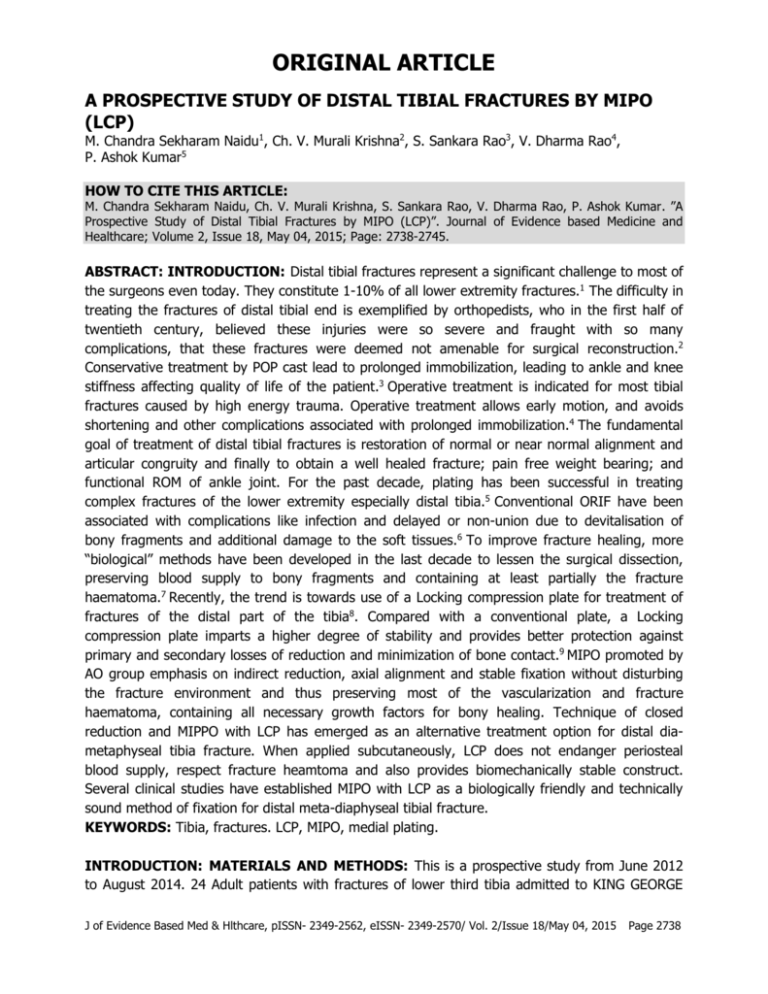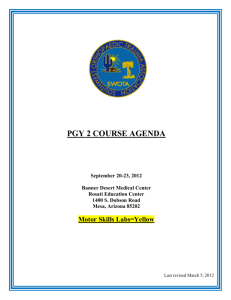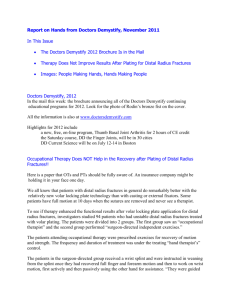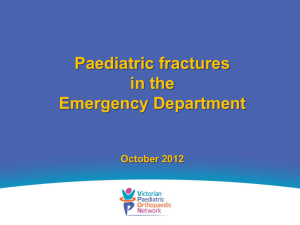a prospective study of distal tibial fractures by mipo (lcp)
advertisement

ORIGINAL ARTICLE A PROSPECTIVE STUDY OF DISTAL TIBIAL FRACTURES BY MIPO (LCP) M. Chandra Sekharam Naidu1, Ch. V. Murali Krishna2, S. Sankara Rao3, V. Dharma Rao4, P. Ashok Kumar5 HOW TO CITE THIS ARTICLE: M. Chandra Sekharam Naidu, Ch. V. Murali Krishna, S. Sankara Rao, V. Dharma Rao, P. Ashok Kumar. ”A Prospective Study of Distal Tibial Fractures by MIPO (LCP)”. Journal of Evidence based Medicine and Healthcare; Volume 2, Issue 18, May 04, 2015; Page: 2738-2745. ABSTRACT: INTRODUCTION: Distal tibial fractures represent a significant challenge to most of the surgeons even today. They constitute 1-10% of all lower extremity fractures.1 The difficulty in treating the fractures of distal tibial end is exemplified by orthopedists, who in the first half of twentieth century, believed these injuries were so severe and fraught with so many complications, that these fractures were deemed not amenable for surgical reconstruction.2 Conservative treatment by POP cast lead to prolonged immobilization, leading to ankle and knee stiffness affecting quality of life of the patient.3 Operative treatment is indicated for most tibial fractures caused by high energy trauma. Operative treatment allows early motion, and avoids shortening and other complications associated with prolonged immobilization.4 The fundamental goal of treatment of distal tibial fractures is restoration of normal or near normal alignment and articular congruity and finally to obtain a well healed fracture; pain free weight bearing; and functional ROM of ankle joint. For the past decade, plating has been successful in treating complex fractures of the lower extremity especially distal tibia.5 Conventional ORIF have been associated with complications like infection and delayed or non-union due to devitalisation of bony fragments and additional damage to the soft tissues.6 To improve fracture healing, more “biological” methods have been developed in the last decade to lessen the surgical dissection, preserving blood supply to bony fragments and containing at least partially the fracture haematoma.7 Recently, the trend is towards use of a Locking compression plate for treatment of fractures of the distal part of the tibia8. Compared with a conventional plate, a Locking compression plate imparts a higher degree of stability and provides better protection against primary and secondary losses of reduction and minimization of bone contact.9 MIPO promoted by AO group emphasis on indirect reduction, axial alignment and stable fixation without disturbing the fracture environment and thus preserving most of the vascularization and fracture haematoma, containing all necessary growth factors for bony healing. Technique of closed reduction and MIPPO with LCP has emerged as an alternative treatment option for distal diametaphyseal tibia fracture. When applied subcutaneously, LCP does not endanger periosteal blood supply, respect fracture heamtoma and also provides biomechanically stable construct. Several clinical studies have established MIPO with LCP as a biologically friendly and technically sound method of fixation for distal meta-diaphyseal tibial fracture. KEYWORDS: Tibia, fractures. LCP, MIPO, medial plating. INTRODUCTION: MATERIALS AND METHODS: This is a prospective study from June 2012 to August 2014. 24 Adult patients with fractures of lower third tibia admitted to KING GEORGE J of Evidence Based Med & Hlthcare, pISSN- 2349-2562, eISSN- 2349-2570/ Vol. 2/Issue 18/May 04, 2015 Page 2738 ORIGINAL ARTICLE HOSPITAL, attached to ANDHRA MEDICAL COLLEGE, Under taken for this study after obtaining their informed, valid written consent. On admission, the patients were then assessed clinically to evaluate their general condition and the local injury. General condition was assessed with the vital signs and systemic examination. Methodical examination was done to rule out fractures at other sites. Local examination of the injured extremity revealed swelling, deformity and loss of function. Palpation revealed abnormal mobility and crepitus at the fracture site. Distal neurovascular status was assessed by the posterior tibial artery and dorsalis pedis artery pulsations, capillary filling, local temperature, pallor and paraesthesia. Antero-posterior and lateral radiographs of the affected leg along with ankle were taken and the fracture patterns were classified based on the AO/OTA classification of fractures of distal tibia. The limb was then immobilized in an above knee Plaster of Paris slab till definitive fixation with locking compression plate done. CLASSIFICATION OF FRACTURES: Fig. 1: The three types and nine groups of the AO/OTA classification of distal tibia fractures is illustrated. The three types are extra articular, Partial articular, and total articular, and they are divided into nine groups, Based on the amount of comminution, as illustrated. Fig. 1 J of Evidence Based Med & Hlthcare, pISSN- 2349-2562, eISSN- 2349-2570/ Vol. 2/Issue 18/May 04, 2015 Page 2739 ORIGINAL ARTICLE Fig. 2: Ruedi and Allgower classified distal tibia fractures into three types Based on the degree of articular comminution, as illustrated. The majority of the literature on fractures of the distal tibia has used this classification. Fig. 2 PROCEDURE: Under spinal/epidural anesthesia under patient supine position c-arm control and tourniquet control, or if of fibula done. which aids the reduction of tibia. 3 to 5 C.M slightly curved incision made on the medial aspect of distal tibia from the tip of the medial malleolus, flaps are not raised, epiperosteal tunnel made towards the diaphysis by blunt tip of plate/ tunneling instrument plate is inserted from distal to proximal on the antero medial surface. Plate is a proximate to bone by using 3.5 mm screws. Fracture is reduced by various reduction maneuvers rest of the screws are applied under c-arm guidance, tourniquet removed haemostasis secured. Wound closed with ethelon. J of Evidence Based Med & Hlthcare, pISSN- 2349-2562, eISSN- 2349-2570/ Vol. 2/Issue 18/May 04, 2015 Page 2740 ORIGINAL ARTICLE RESULTS AND ANALYSIS: Functional results were evaluated based on classification system for result of treatment by oleaur & mollander et al. All Patients were followed up at regular interval i.e. 3 months, 6 months, 12 months, 18 months and 24 months. Ankle/ subtalar motion Excellent >75% normal Good 50-75% Fair 25-50% Poor <25% Rating Tibiotalar alignment Normal Normal 0 <5 angulaton >50 angulation Tibial shortening None None <1cm >1cm Chronic swelling None Minimal Moderate Severe Equines deformity None None None Present Table 1: Showing objective criteria Rating Pain Excellent Good None Mild Return to work Same work Same work Fair Moderate Modified Poor Severe Unable Recreational activity Normal Mild modification Significant modification None Limited walking No No Pain medication None None Yes Non-narcotic Occasional Yes Narcotic Yes Limp None None Table 2: Showing subjective criteria Results No. of cases Percentage Excellent 16 66.7 Good 4 16.7 Fair 2 8.3 Poor 2 8.3 Table 3: Showing objective results Results No. of cases Percentage Excellent 14 58.3 Good 5 20.8 Fair 4 16.7 Poor 1 4.2 Table 4: showing subjective results J of Evidence Based Med & Hlthcare, pISSN- 2349-2562, eISSN- 2349-2570/ Vol. 2/Issue 18/May 04, 2015 Page 2741 ORIGINAL ARTICLE At the end of the present study of 24 patients treated 14(58.3%) patients had excellent outcome, 5(20.8%) had good results, 4(16.7%) had fair outcome and 1(1.2%) had a poor result. COMPLICATIONS: Widespread use has brought about a series of unique complications. However, as with every other technique, adherence to basic principles and use of proper technique can keep complications to a minimum. ANKLE STIFFNESS: Ankle stiffness is frequent if plate fixation at distal end is improper leading to prolonged immobilization at ankle joint. DELAYED UNION: The improper reduction and fixation of plates with cancellization and weakening of the cortex. The callus produced is entirely endosteal, and delayed unions are rare entities with definitive and rigid fixation. DISCUSSION: Fractures of the distal tibia were among the most difficult fractures to treat effectively. The primary goal of operative treatment is to anatomically align the fractures fragments while providing enough stability to allow early motion. This study was chosen to determine the efficacy of the MIPO with LCP in the treatment of the distal tibial meta-diaphyseal fractures. Our study revealed the average age of the patient with such injuries is 40.8 yrs (22-58). In the study of Cory colling etal10 mean age was 43 years while in that of Heather A Vallier etal11 it was 39.8 years. In our study, the male preponderance for these kind of fractures was very high 87.5 when compared to the study by Cory collinge et al, which was 67% most probably due to the reason of male dominance over the female in travelling, occupational injuries etc., in India. The average surgical time was 54.17 minutes in our study with a range of 31-80 minutes. It is comparable with the average of 97.9 minutes taken by J.J Guo et al in their study. The length of the operative time during the fixation of fractures reflects the significant learning curve of the surgical technique. The first few locking plates took 60-80 minutes in this study, where the most recent ones took 30-40 minutes. Our study had an average fracture union of 16 weeks J of Evidence Based Med & Hlthcare, pISSN- 2349-2562, eISSN- 2349-2570/ Vol. 2/Issue 18/May 04, 2015 Page 2742 ORIGINAL ARTICLE which were comparable with studies conducted using the locking compression plates. Cory collinge et al had an average union of 21 weeks and abidmushtaq et al had an average of 22 weeks. Study Methods Acceptable Not acceptable 12 Ruedi and Allgower 74 26 13 Mast et al 78 22 14 Bourne et al ORIF with anatomic plate 44 56 15 Teeny and Wiss 50 50 16 Im GI et al 88 12 17 Gao et al 87 13 18 Hazarika et al 87 13 MIPPO WITH LCP 19 Ozkaya U. et al 81 19 Present study 87 13 NB: The excellent and good results have been tabulated as acceptable and the fair and poor results as not acceptable for easier comprehension. Pre OP X Rays Post OP 3D CT Picture Final Follow Up J of Evidence Based Med & Hlthcare, pISSN- 2349-2562, eISSN- 2349-2570/ Vol. 2/Issue 18/May 04, 2015 Page 2743 ORIGINAL ARTICLE Clinical Photographs at Final Follow Up CONCLUSION: According to this study, 24 patients with fractures of the distal tibia which have undergone closed reduction through MIPPO techniques and application of the locking compression plates states that this technique has resulted in the strong and effective stabilization of these fractures. It does provide excellent stability and allows early range of motion at ankle. The closed reduction not only helps in achieving reduction in difficult situations, but also in rapid union, because it facilitates preservation of the blood supply to the fragment and helps to achieve near normal anatomical reduction of the fracture. Finally we conclude with our study of 24 patients with 24 fractures reviewed which included types A1, A2, A3 distal tibial fractures that our results are comparable with earlier studies and showed 87% of good and excellent results. REFERENCES: 1. Sirkin M, Sanders R. The treatment of pilon fractures. Clinic Orthop 2001; 32(1): 91-102. 2. Martin JS, Marsh JL, Bonar SK, De Coster TA, Found EM. Assessment of the AO/ASIF fracture classification for the distal tibia. J Orthop Trauma 1997; 11: 477-483. 3. Charnley J. The closed treatment of common fractures. Cambridge. Colt Books Ltd., 1999. 4. AsheeshBedi, MD, T. Toan Le, MD and Madhav A. Karunakar, MD.Surgical Treatment of Nonarticular Distal Tibia Fractures 2006 by the American Academy of Orthopaedic Surgeons. 5. Collinge C, Sanders R, dipasquale T. Treatment of complex tibialPeriarticular fractures using percutaneous techniques.Clin Orthop Relat Res.2000; 375: 69-77. 6. Shrestha D, Acharya BM, Shrestha PM. Minimal invasive plate osteosynthesis with locking compression plate for distal diametaphyseal tibia fracture. Kathmandu Univ Med J 2011; 34(2) 62-8. 7. Jens FRANCOIS, Geoffroy VANDEPUTTE, Frank VERHEYDEN, Guy NELEN.Percutaneous plate fixation of fractures of the distal tibia Acta Orthop. Belg., 2004, 70, 148-154. 8. Hasenboehler E, Rikli D, Babst R. Locking compression plate with minimally invasive plate osteosynthesis in diaphyseal and distal tibial Fracture: a retrospective study of 32 patients. Injury. 2007; 38: 365–370. J of Evidence Based Med & Hlthcare, pISSN- 2349-2562, eISSN- 2349-2570/ Vol. 2/Issue 18/May 04, 2015 Page 2744 ORIGINAL ARTICLE 9. Kaab MJ, Frenk A, Schmeling A, Schaser K, Schutz M, Haas NP. Locked internal fixator: sensitivity of screw/plate stability to the correct Insertion angle of the screw. J Orthop Trauma. 2004; 18: 483–487. 10. Collinge C, Protzman R. Outcomes of minimally invasive plate Osteosynthesis for metaphyseal distal tibial fractures. J. Orthop Trauma 2010; 24: 24-29. 11. Heather.A. Vallier, T. Toan le, AsheeshBedi. Radiographic and clinical Comparisons of distal tibia shaft fractures (4-11 cms proximal to Plafond) plating versus intramedullary nailing. J OrthopTrauma 2008; 22: 307 311. 12. Ruedi TP, Allgower M. The operative treatment of intra articular Fractures of the lower end of tibia. ClinOrthop 1979; 138: 105-110. 13. Mast JW, Spiegel PG, Pappas JN. Fractures of tibialpilon. ClinOrthop 1988; 230: 68-82. 14. Bourne R, Rorabeck C, Macnab J. Intra-articular fractures of the distal Tibia: The pilon fracture. J Trauma 1983; 23: 591-596. 15. Teeny S, Wiss DA, Hathaway R. Tibial plafond fractures, errors, Complication and pitfalls in operative treatment. Orthop Trans 1990; 14: 16. Im GI, Tae SK. Distal metaphyseal fractures of tibia: a prospective Randomized trial of closed reduction and intramedullary nail versus open Reduction and plate and screws fixation. J Trauma. 2005 Nov; 59(5): 1219-23; discussion 1223. 17. GaoH,Zhang CQ, Luo CF, Zhou ZB, Zeng BF. Fractures of the distal Tibia treated with polyaxial locking plating. Clin Orthop Relat Res.2009Mar; 467(3): 831-7. Epub 2008 Aug 22. 18. Hazarika S, Chakravarthy J, Cooper J. Minimally invasive locking plate Osteosynthesis for fractures of the distal tibia – Injury. 2006 Sep; 37(9): 877-87. Epub 2006 Aug 8. 19. Ozakaya U, Parmaksizoglu AS, Gul M, Sokuou S, Kabukcuoglu Y. Minimally invasive treatment of distal tibial fractures with locking and non-locking plates. Foot Ankle Int.2009 Dec; 30(12): 1161-7. AUTHORS: 1. M. Chandra Sekharam Naidu 2. Ch. V. Murali Krishna 3. S. Sankara Rao 4. V. Dharma Rao 5. P. Ashok Kumar PARTICULARS OF CONTRIBUTORS: 1. Assistant Professor, Department of Orthopaedics, Andhra Medical College, Visakhapatnam. 2. Assistant Professor, Department of Orthopaedics, Andhra Medical College, Visakhapatnam. 3. Assistant Professor, Department of Orthopaedics, Andhra Medical College, Visakhapatnam. 4. Professor, Department of Orthopaedics, Andhra Medical College, Visakhapatnam. 5. Associate Professor, Department of Orthopaedics, Andhra Medical College, Visakhapatnam. NAME ADDRESS EMAIL ID OF THE CORRESPONDING AUTHOR: Dr. M. Chandra Sekhar Naidu, Assistant Professor, Department of Orthopaedics, Andhra Medical College, Visakhapatnam-2. E-mail: naidumajjivizag@gmail.com Date Date Date Date of of of of Submission: 24/04/2015. Peer Review: 25/04/2015. Acceptance: 29/04/2015. Publishing: 04/05/2015. J of Evidence Based Med & Hlthcare, pISSN- 2349-2562, eISSN- 2349-2570/ Vol. 2/Issue 18/May 04, 2015 Page 2745






